Integrated Marketing Communication (IMC) was first coined in 1989 and has continued to grow. IMC is an essential strategy that business owners and marketers need to understand to create consistency for their products or brand.
In the modern era, IMC is increasingly gaining popularity due to the development of the internet that offers new media for marketing, which process can be managed by a Marketing Automation Software. Consequently, traditional media such as newspapers, television, and radio are no longer the only option. As many media options grow, business people realize they need a planning system to integrate numerous marketing communication channels to reach their target market.
Table of Content:
Table of Content
What is Integrated Marketing Communication (IMC)?
IMC is a strategy in which all marketing channels the company uses can convey a consistent and clear message. With this strategy, potential customers will get the same perception of the company and its products.
You may be familiar with the billboards commonly found on the street. Using the IMC strategy, the billboard’s content needs to have the same impression as other advertisements. For example, if you have an image of luxury brands and products on social media, your street billboards should reflect the same luxury.
The Benefits of IMC Strategy
The growing popularity of integrated marketing communication is not without reason. There are many goals and benefits that your company can achieve by implementing an IMC strategy, including the following:
- The IMC strategy attempts to transmit a consistent message to potential clients effectively.
- The IMC strategy aims to form a brand image that consumers can quickly identify. To achieve this goal, organizations must consider their brand features such as logos, colors, and content.
- The IMC strategy contributes to a positive customer experience and a successful business connection.
Types and Examples of IMC

Because IMC is a strategy that uses multiple marketing channels, IMC has several types, which we will describe below.
Ads
Advertisements are use in various media, including television, radio, and the internet. Because they can reach from the national to the global level, the reach of potential customers is quite broad. Therefore, they use advertisements to pique potential customers interest by emphasizing the product’s benefits.
Public relations
Public relations aims to attract new customers and maintain the loyalty of old customers. They will be heavily involved in the communication process with the target market so that the company’s reputation is well maintained. Public relations emphasizes managing customer perceptions of a business or company. In this way, public relations will further build consumer confidence in the company.
Sales promotion
There are times when a company finds a situation where they need sales escalation. That’s when they usually use strategy sales promotion. Companies create campaigns or limited offers to increase interest in a product or service to carry out this marketing strategy. The types of sales promotion offers include challenges on social media, product bundles, flash sales, free trials, and others. You can manage all your strategy in increasing your business’ sales by using a Sales Management System to sell smarter, faster, and effectively.
Event & experience
Although it sounds the same, the event & experience strategy is a different and separate strategy. One of the main differences between the two strategies is how each strategy communicates with consumers. The use of one-way communication by the event strategy does not allow consumers to respond to words from the brand. In contrast, the experience strategy will enable consumers to interact with products and services because it uses two-way communication.
Also read: 6 Benefits of Event Management Software that You Must Know
Direct selling
Direct selling is an assertive marketing approach that involves salespeople from companies who will directly convey persuasive messages to potential customers. This strategy is an effective way to build customer relationships at a low cost. Several things that affect the low cost include the absence of advertising or expensive overhead costs so that direct selling can be carried out flexibly. Even so, in carrying out this strategy, salespeople need to show their goals and professionalism so that later legitimate sales are created.
Implementation Process of IMC

If you believe your company should implement the IMC strategy, the following are the actions to take.
Analysis of the situation, condition, and target market
The first step that companies need to take to carry out integrated marketing communication is to analyze the situation, conditions, and target market or audience. This initial analysis will find the problem points of the market, and the company will determine what solutions they must do.
Analysis of the purpose of using IMC
The company’s objectives must explain the impact of IMC activities on the target market and the final results. Companies can start setting goals by considering the cognitive stages that potential customers go through when buying a product or service. One model that is widely used is the AIDA model, namely awareness, interest, desire, and action.
Prepare the IMC budget
Determining the IMC budget has various objectives to support smooth implementation. With the specified budget, the company will find it easier to prioritize activities to carry. Some of the other essential goals are transparency, controlling resources, motivation to strive to achieve budget goals, and making it easier to communicate plans to various other divisions. HashMicro offers a Financial Management Software to help manage your finances.
Implementation of IMC
In the previous section, we have described the types of IMC and some examples. The company can combine these marketing activities to make it easier to keep track of them. Even so, each employee must still have their respective responsibilities according to their competence.
Monitoring and evaluation of IMC
The final stage of the process of conducting IMC is monitoring and evaluation. To do this, draw up any criteria that require evaluation results and adjust them to what is happening in the field. This step is important to ascertain how the previous steps were carried out if they succeeded or failed to achieve the previously set goals. After these things are discovered, the company can use the evaluation results to take appropriate steps to improve the following IMC implementation.
Also read: How to Successfully Conduct a Year-End Profit Review
Conclusion
Like any other business process, marketing requires an organized plan to achieve the targets set by the company. To help your marketing process, HashMicro offers a Marketing Automation System to optimize marketing efforts to be right on target, have conversion analysis, and generate comprehensive reports. There are also many features in this system, such as Custom Trigger Management, that you can install to detect every subscriber; when clicking certain buttons or entering and exiting specific segments. So, try the free demo now!





































